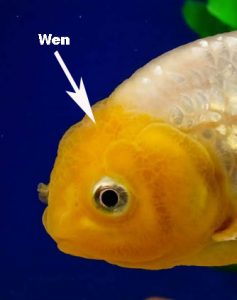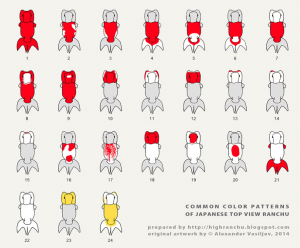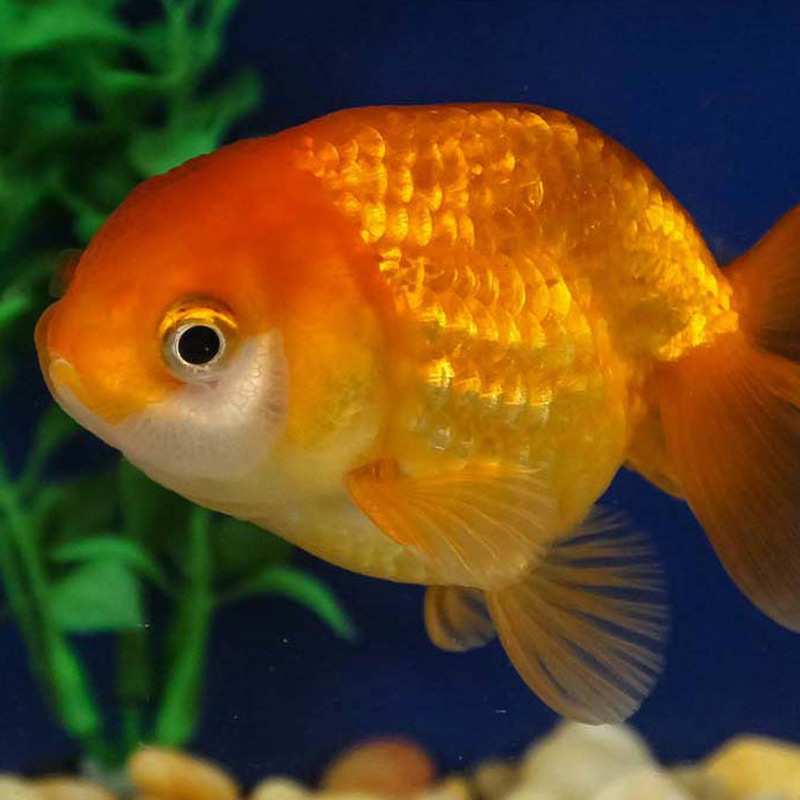Carassius auratus (or Ranchu Fancy Goldfish) actually goes by quite a few different handles. What the rest of the world knows as Ranchu Goldfish, Asia more commonly refers to as the Buffalo-head Goldfish or (just Buffalo head) thanks to its squat appearance and prominent head.
Because of the rounded body and large head, along with its Japanese heritage, it is compared to a sumo wrestler.
Ranchu are highly prized. In Japan, they are referred to as the “King of the Goldfish” and are highly-regarded fancy goldfish.
Ranchu Goldfish Origins
The modern Ranchu is recognized as being a Japanese varietal of fancy goldfish. However, the Ranchu started life as a Chinese fancy goldfish of Lionhead descent. When Ranchu first came to Japan in the 1600s, they were referred to as Maruko (or Korean Goldfish), so it is likely that they came to Japan via Korea.
It wasn’t until the 1800s that the wen started to develop through selective trait breeding. At that time, the Ranchu we see in our tanks today evolved. By the early 1900s, the arched back became a trait.
Ranchu Goldfish Appearance
Ranchu, like Lionhead, are an egg-shaped fancy goldfish, with broad, arched backs (unlike the Lionhead) and deep body, with the body accounting for anywhere from ⅝ to ¾ of the entire length of the fish.
 The Ranchu also has a fleshy, “brain-like” hood (or wen). The size of the wen can vary from fish to fish. Some can cover the entire head (even affecting its vision!) whereas others are much smaller
The Ranchu also has a fleshy, “brain-like” hood (or wen). The size of the wen can vary from fish to fish. Some can cover the entire head (even affecting its vision!) whereas others are much smaller
While Lionhead and Ranchu goldfish are often mistaken for one another, there are some subtle differences.
One characteristic that distinguishes the two breeds is the size and coverage of the wen. A Ranchu wen should look like it starts toward the bottom of the gill plate cover and moves upward over the head. Typically, a Ranchu wen can cover more than just the head, but it is a slightly smaller hood than that of a Lionhead.
The tail fin is classified as a fantail with rounded lobes (that should resemble a well-developed swallow’s tail). A Ranchu’s tail fin is smaller and less intricate than a Lionhead’s, looking more like a Comet’s caudal (tail) fin. Additionally, the tail fin is attached to the caudal peduncle at 45º so that the tail turns down.
One of the most instantly-recognizable features of this fancy goldfish is that it lacks a dorsal fin. This does affect the maneuverability of the Ranchu in the water. Coupled with its natural plumpness, the Ranchu is less agile than some other fancy goldfish and almost all of the regular pond goldfish.
Ranchu are described as resembling sumo wrestlers because their wide, round (or egg-shaped) bodies and prominent heads give them a Sumo-like appearance.
A fully-grown Ranchu can grow to be 8 inches long but usually ranges from 4-6 inches. Given optimal conditions, Ranchu have been known to live upwards of 20 years.
Ranchu Goldfish Coloration
 Ranchu come in a variety of colors that include solid pigmentation or combinations thereof. Red, orange, yellow, gold, white, blue, black, and calico are common. However, in Japan, where the Ranchu is viewed from above, Calico is not considered a color.
Ranchu come in a variety of colors that include solid pigmentation or combinations thereof. Red, orange, yellow, gold, white, blue, black, and calico are common. However, in Japan, where the Ranchu is viewed from above, Calico is not considered a color.
Additionally, Ranchu come in many different color combinations and patterns. This chart breaks down many of those patterns.
Although originally bred from a metallic-scaled fish, Ranchu also come in nacreous and matte scalation patterns.
A Ranchu’s colors can change as it matures, sometimes entirely, with white being the color most likely to show up later in life.
Interesting fact: At fish shows in Asia, the Ranchu Fancy Goldfish is judged from the side, whereas in Japan, it is judged from above so as to appreciate the broadness of the back!
Keeping a Ranchu
These fancy goldfish don’t get particularly large, however you do want to provide them some space to swim in. As a rule of thumb, you should have 10 gallons of water minimum per fish, which you should consider when deciding which tank to buy.
The frequency of water changes impacts a younger Ranchu’s growth. Cleaner water promotes swimming, which in turn increases muscle and body growth. In dirtier (three-day-old) water, fish won’t swim as much so the nutrients then move to the wen. So, more frequent water changes will promote body growth and less frequent changes are useful for head growth.
Also, keep the decor to a minimum in your tank. Anything with sharp edges can cause injury to the Ranchu and its wen. Smooth gravel is also suggested, as they will root through it looking for food.
Ranchu like to nibble on aquatic plants, so if you have any in your pond or tank, expect them to be eaten.
Best Ranchu Goldfish Tank Mates
Because they lack a dorsal fin, Ranchu aren’t the most agile of fancy goldfish. This means that they are not going to be first at the dinner table. To give them a better chance at keeping their robust appearance, fast-moving fancy goldfish aren’t good choices as pond mates.
Instead, Ranchu are better off being with other slow swimmers like the Bubble Eye, Telescope, Celestial Eyed or Lionhead.
Ranchu Goldfish Diet
As omnivores, Ranchu can eat a broad range of food types besides pellets and flakes. Some enthusiasts don’t recommend pellet or flake food at all as neither are part of their natural diet.
Some of the more common menu items are frozen bloodworms, insects, algae, peas and broccoli. Younger Ranchu, however, will require more protein for growth.
Some enthusiasts even create a gel comprised of a mixture of fish, fish oil, grains, essential vitamins and some vegetables. Here is a video that looks at how to make a paste.
One caution to consider with fresh food is the potential for parasites.
To get the maximum potential from a Ranchu, the recommended feeding schedule is small amounts (and only as much as they can eat in 1-2 minutes) but more frequently throughout the day, sometimes up to as many as 6 times a day. An automatic feeder can be helpful to keep this schedule.
Because of their body structure, poor eyesight and slow swimming, Ranchu usually take a little longer to feed (which is why it is not recommended to pair them with quick swimming fish as they can quickly become malnourished).
Some Ranchu Goldfish Maintenance Tips
As the wen is prone to bacterial infections, clean water and regular water changes are important.
Keep your Ranchu in pairs or with other slow swimming fish. They are social creatures and like to be together.
Choose a filter that doesn’t create too big of a stream. Ranchu are not strong swimmers and this will make it more difficult for them.
If you are not an experienced fancy goldfish keeper, it is not recommended to keep a Ranchu. Their body shape and the delicate and slow swimming nature make them a more difficult goldfish to keep.


[…] a regular lionhead goldfish is much more rounded and this is easier to spot when viewed from above. Ranchu tails also hang at a 45 degree angle, whereas lionhead goldfish tails are showier and flare more. Check also for a distinctive shoulder […]